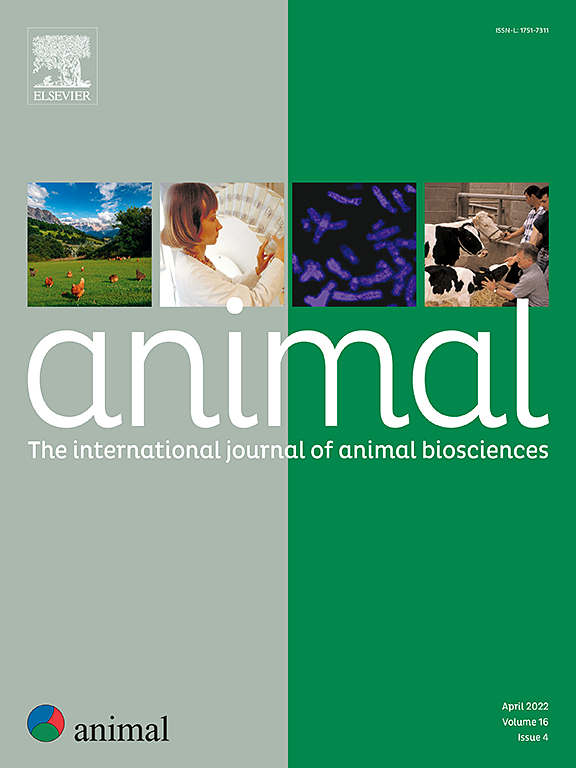The effects of gamma-aminobutyric acid on growth performance, diarrhoea, ruminal fermentation, and antioxidant capacity in pre-weaned calves
IF 4
2区 农林科学
Q1 AGRICULTURE, DAIRY & ANIMAL SCIENCE
引用次数: 0
Abstract
The pre-weaning phase is a vital period for the growth and development of calves, significantly impacting their future health and productivity. Gamma-aminobutyric acid (GABA) is an inhibitory neurotransmitter in the mammalian central nervous system that lowers blood pressure, stimulates feed intake, and enhances antioxidant capability. Gamma-aminobutyric acid has been proven beneficial for adult cows, while little research has been conducted on calves. Therefore, this study examined the effects of GABA on growth performance, diarrhoea, ruminal fermentation, and antioxidant capacity in pre-weaned Holstein calves. Ninety male Holstein calves were allocated to five groups: 0 mg/d (G0), 25 mg/d (G25), 50 mg/d (G50), 100 mg/d (G100), and 200 mg/d (G200). The experiment was conducted from 11 to 75 days of calves age, and the calves were weaned at 75 days of age. Growth performance indicators, ruminal fluid, faecal score, and serum were collected at 11, 28, 42, 60, and 75 days of calves’ age. The results showed that adding GABA positively affected average daily gain and body height, with no effects on diarrhoea frequency. All dosages significantly reduced acetate and total volatile fatty acid levels in ruminal fermentation, with butyrate showing a complex response at higher doses. Overall, we recommended 100 mg/d as the optimal GABA supplementation level to improve growth performance and regulate the ruminal fermentation of pre-weaned calves before weaning.
γ -氨基丁酸对断奶前犊牛生长性能、腹泻、瘤胃发酵和抗氧化能力的影响
断奶前阶段是犊牛生长发育的关键时期,对犊牛未来的健康和生产能力有重大影响。γ -氨基丁酸(GABA)是哺乳动物中枢神经系统中的一种抑制性神经递质,具有降低血压、刺激采食量和增强抗氧化能力的作用。-氨基丁酸已被证明对成年奶牛有益,而对小牛的研究却很少。因此,本研究旨在研究GABA对断奶前荷斯坦犊牛生长性能、腹泻、瘤胃发酵和抗氧化能力的影响。将90头荷斯坦公犊牛分为5组:0 mg/d (G0)、25 mg/d (G25)、50 mg/d (G50)、100 mg/d (G100)和200 mg/d (G200)。试验于犊牛11 ~ 75日龄进行,75日龄断奶。分别于犊牛11、28、42、60和75日龄采集生长性能指标、瘤胃液、粪便评分和血清。结果表明,添加GABA对平均日增重和身高有积极影响,对腹泻频率没有影响。所有剂量均显著降低了瘤胃发酵中乙酸和总挥发性脂肪酸水平,高剂量丁酸表现出复杂的反应。综上所述,我们推荐100 mg/d的GABA添加水平可提高断奶前犊牛的生长性能并调节断奶前瘤胃发酵。
本文章由计算机程序翻译,如有差异,请以英文原文为准。
求助全文
约1分钟内获得全文
求助全文
来源期刊

Animal
农林科学-奶制品与动物科学
CiteScore
7.50
自引率
2.80%
发文量
246
审稿时长
3 months
期刊介绍:
Editorial board
animal attracts the best research in animal biology and animal systems from across the spectrum of the agricultural, biomedical, and environmental sciences. It is the central element in an exciting collaboration between the British Society of Animal Science (BSAS), Institut National de la Recherche Agronomique (INRA) and the European Federation of Animal Science (EAAP) and represents a merging of three scientific journals: Animal Science; Animal Research; Reproduction, Nutrition, Development. animal publishes original cutting-edge research, ''hot'' topics and horizon-scanning reviews on animal-related aspects of the life sciences at the molecular, cellular, organ, whole animal and production system levels. The main subject areas include: breeding and genetics; nutrition; physiology and functional biology of systems; behaviour, health and welfare; farming systems, environmental impact and climate change; product quality, human health and well-being. Animal models and papers dealing with the integration of research between these topics and their impact on the environment and people are particularly welcome.
 求助内容:
求助内容: 应助结果提醒方式:
应助结果提醒方式:


